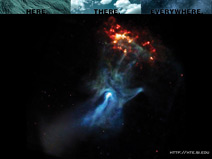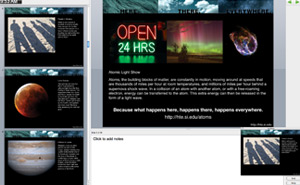


- MAKE YOUR OWN EXHIBIT
- WATCH A VIDEO
- READ A BLOG
- TACTILE & BRAILLE HTE
- AMERICAN SPACES
- PIN SOME IMAGES
- SHARE WITH A FRIEND

Topics: the flow of electric charge.
You are shuffling along a carpet and reach out to touch the doorknob and - zap! - a sudden electric discharge gives you a mild shock. The friction between your feet and the carpet has produced a large build-up of negative electric charge, on your finger. This produces a electric potential difference, or voltage, between your
finger and the doorknob. If the electric potential difference is large enough, a sudden flow of current, called an electric discharge, will occur. Violent electric discharges are responsible for some of the most spectacular displays of sudden energy release on Earth and in space.

- Arc Welder.
- Because of the large electric voltage between the welder's tool and the metal, sparks fly and a strong electric current flows, generating a brilliant light display and enough heat to melt the metal and allow it to bond to another metallic surface.
- Image: Wiki Commons
- Lightning.
- In massive storm clouds, the friction between large particles composed of many atoms builds up a large separation of electric charge, and creates voltages approaching 100 million volts. When the voltage becomes this large, it can cause an explosive electric discharge observed as a lightning bolt.
- Image: Stock Photography
- Spinning Stars.
- An electric voltage can also be produced by the rotation of a magnet in the presence of an electrical circuit. This is the principle behind a generator. Rapidly spinning, highly magnetic neutron stars can act as generators and produce electric voltages in excess of a trillion volts. The energy released by these cosmic super-generators can light up clouds that extend over several light years.
- Image: NASA/CXC/NCSU/K.J.Borkowski et al.
Where can electric discharges occur?
Here, there, and everywhere that electric voltages are large enough. For example, in an arc welder, a storm cloud, and around rapidly a spinning neutron star.
Related Resources

"Here, There, & Everywhere" (HTE) is supported by the National Aeronautics and Space Administration under grant NNX11AH28G issued through the Science Mission Directorate.
HTE was developed by the Chandra X-ray Center, at the Smithsonian Astrophysical Observatory, in Cambridge, MA.
Email: cxcpub@cfa.harvard.edu | Phone: 617.496.7941
Follow us: #HTEScience on Twitter






